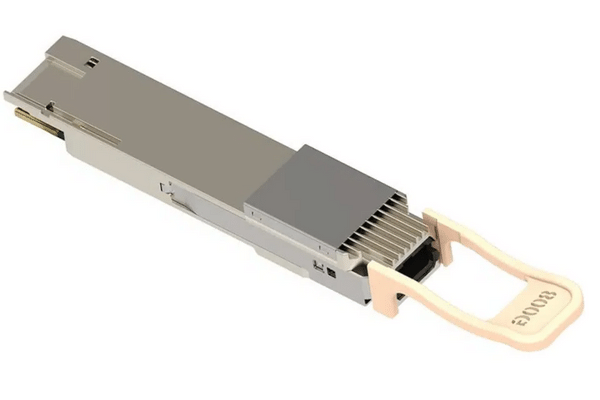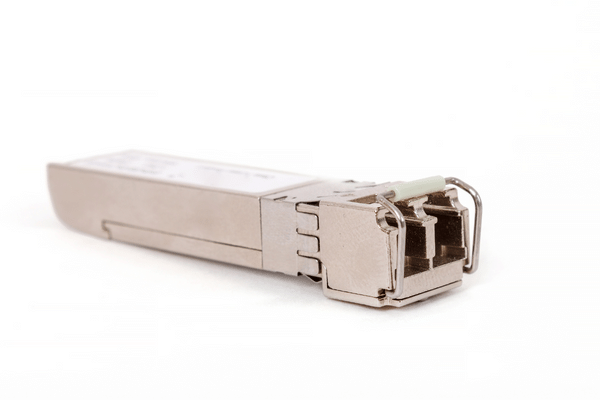Experience unparalleled network performance with the 800G OSFP Optical Transceiver Module. Our advanced solution equips your network with unmatched speed and reliability, paving the way for high-performance connectivity. Designed for modern-day network challenges, the 800G OSFP is intricately engineered to deliver superior data transmission, ensuring seamless communication across your infrastructure. Harness the power of high-speed networking with 800G OSFP and light your network with high-speed connectivity, transforming your network operations and providing the necessary speed for future innovation.

An OSFP (Octal Small Form Factor Pluggable) Optical Transceiver Module is a groundbreaking technology that fundamentally expands the capabilities of network systems. It’s an advanced, high-speed transceiver module that capitalizes on fiber-optic technology to transmit and receive data at remarkable speeds. The 800G OSFP version, in particular, boasts an eight times more bandwidth capacity than the conventional 100G modules. Its compact design allows for denser port configuration on networking equipment, ensuring more efficient space utilization. The 800G OSFP embodies next-generation networking, offering unrivaled performance and setting the standard for high-speed, resilient, and future-ready networks.
High-speed connectivity, offered by the 800G OSFP Optical Transceiver Module, is paramount in today’s digital landscape. It fuels the efficient and rapid data transmission across numerous platforms, enabling businesses to meet the demands of latency-sensitive applications and high-volume data processing. Connectivity at such high speeds supports the seamless operation of cloud services, artificial intelligence (AI), machine learning, and other cutting-edge technologies crucial to staying competitive in the 21st century. The superior bandwidth and speed of the 800G OSFP play a critical role in preventing network bottlenecks and ensuring uninterrupted, smooth operation – a vital factor for businesses where downtime equates to revenue loss. Furthermore, high-speed connectivity is a crucial enabler of innovation, offering the robust infrastructure required to explore and implement new technologies, thereby accelerating digital transformation.

The 800G OSFP Transceiver is the epitome of sophisticated optical technology, offering unparalleled network performance by employing high-speed data transmission. Its main advantage lies in its capability to handle eight times more bandwidth than conventional 100G modules, allowing for seamless, high-volume data processing.
The 800G OSFP Transceiver brings several advantages to the table, setting it apart in high-speed data transmission.
In essence, the 800G OSFP Transceiver is a game-changer, paving the way for future networks with its exceptional speed, high-density design, scalability, cost-efficiency, and future-proof features.
The 800G OSFP Transceiver is loaded with a range of critical features that combine to provide supreme network performance:
The 800G OSFP Transceiver is a powerhouse of features, providing unparalleled performance, scalability, and sustainability for high-speed network connectivity.
The 800G OSFP Transceiver finds many applications in many sectors, owing to its robust, high-speed performance and scalability.
In conclusion, the 800G OSFP Transceiver, with its exceptional performance and future-oriented features, is a versatile solution suitable for various applications in the modern digital landscape.

An optical transceiver module is a critical component in fiber optic communication, which plays a crucial role in converting electrical signals into optical signals and vice-versa. These modules encompass two primary functions: a transmitter that converts electrical signals into light pulses and a receiver that reverts the light pulses into electrical signals. The high-speed capabilities of optical transceivers, like the 800G OSFP, have revolutionized data communication, offering unprecedented speed, bandwidth, and scalability, thereby accommodating the ever-growing demand for efficient data transmission in various sectors, including data centers, telecommunications, and digital broadcasting.
There are several types of optical transceiver modules, each designed to meet specific networking and communication needs.
These transceivers offer unique benefits and features, making them suitable for different applications. The choice of transceiver ultimately depends on the network’s specific requirements, such as distance, speed, and compatibility with existing network infrastructure.
Optical transceiver technology has undergone tremendous advancements over the years, driven by the increasing data rate demands and evolving network infrastructure needs. One of the most notable developments is the advent of the 800G OSFP Optical Transceiver, a breakthrough technology that has reshaped high-speed data communication. This innovative transceiver brings eight times the bandwidth of a conventional 100G transceiver, offering superior speed, lower power consumption, and enhanced scalability.
Moreover, advancements in direct attach cables (DAC) and active optical cables (AOC) technology have improved operational efficiency and cost-effectiveness. The introduction of quad data rate (QDR) and PAM4 modulation have also played pivotal roles in increasing the data transfer rates, allowing for higher capacity and faster data transmission.
Furthermore, the emergence of Silicon Photonics is revolutionizing the optical transceiver technology landscape. This technology uses integrated circuits fabricated from silicon to transmit optical signals, thereby enabling faster, more efficient data transfer.
These advancements in optical transceiver technology are fueling the growth of high-speed networking and paving the way for future innovations in data communication. As data demands continue to grow, we can expect further leaps in the evolution of optical transceiver technology.

Regarding high-speed data communication, one of the most prominent options is the 800G OSFP Transceiver Module. These modules are a technologically advanced solution designed to meet the rising demands of data centers, telecommunications, and digital broadcasting.
800G OSFP Transceiver Modules are characterized by their exceptional data transfer speed, reaching up to 800 Gigabits per second. This unprecedented speed is coupled with low power consumption and high density, making them an optimal choice for high-performance networks.
800G QSFP-DD800 Transceivers stand out with their high-speed data transmission capability and compatibility with existing MSA standards. These transceivers utilize PAM4 modulation, allowing them to transmit more data within the same signal period, thus enhancing their overall data-carrying capacity.
The OSFP Pam4 1310nm 2km DOM Dual Transceivers are another robust option that provides reliable, high-capacity data transmission over short distances. These transceivers are designed with Digital Optical Monitoring (DOM), enabling real-time monitoring of the transceiver’s performance parameters, thus ensuring optimal operation and early fault detection.
Duplex LC 2km SMF Optical Transceiver Modules are designed for robust, long-distance data transmission. These modules use two fiber strands, one for transmitting and one for receiving data, maintaining data integrity over extended distances. Their use of Single-Mode Fiber (SMF) technology allows for data transmission over long distances without significant signal loss.
Each of these 800G OSFP Transceiver Module options offers unique capabilities, fulfilling high-speed data communication needs. The choice of module will depend on the particular demands and constraints of the networking environment.

Data centers frequently require high-speed data communication to manage large volumes of data efficiently. The 800G OSFP Transceiver Modules can significantly optimize data center connectivity, providing lightning-fast data transmission alongside power efficiency and robustness.
800G OSFP transceivers are particularly suitable for breakout applications, where a single high-speed link is split into multiple lower-speed links. The high data transmission capability of the 800G OSFP transceivers, coupled with their compatibility with existing MSA standards, make them ideal for such applications.
Active Optical Cables (AOC) are commonly used in data centers for short-range multi-lane data communication and interconnect applications. The 800G OSFP Transceiver Modules work seamlessly with AOC, providing efficient, high-capacity data transfer.
In situations where data needs to be converted from one media type to another, such as from copper to optical fiber, Fiber Media Converters are used. The 800G OSFP Transceiver Modules, with their high-speed data transfer capacity and compatibility with a range of fiber types, are an excellent choice for use with Fiber Media Converters.
In conclusion, whether it’s enhancing data center connectivity, breakout applications, use with active optical cables, or fiber media converters – the 800G OSFP Transceiver Modules are a game-changer in high-speed data communication.
High-density interconnect solutions are a vital application of 800G OSFP Transceiver Modules. These modules offer a high port density, packing more data transfer capacity into a smaller space, which is crucial for data centers and telecommunication networks where area is often at a premium.
Fiber to the x (FTTx) environments stand to benefit significantly from the deployment of the 800G OSFP Transceiver Modules. In these settings, where the last mile of connectivity is paramount, the vast data carriage capabilities, coupled with a lower power consumption of these modules, can significantly boost network performance and reliability.
800G OSFP Transceiver Modules are also transforming the landscape of optics storage networking. These modules, with their exceptional data transfer speeds and compatibility with various fiber types, make data-intensive operations such as real-time analytics, AI and machine learning, and cloud computing more efficient and cost-effective, thereby driving the evolution of modern storage networking.
Regarding compatibility, the 800G OSFP Transceiver Modules shine, showing immense versatility. They are designed to be compatible with various other transceiver modules, ensuring seamless integration in diverse networking environments.
Understanding the role of Optical Transport Network (OTN) in high-capacity data transfer. The 800G OSFP Transceiver Modules support OTN functionality, contributing to improved signal integrity, network management, and overall performance.
Optical interconnect solutions are becoming increasingly important in modern data centers. The 800G OSFP Transceiver Modules are designed to seamlessly integrate with these solutions, thus facilitating high-speed data transfers across short, medium, and long distances.
Ensuring compatibility with various transceiver standards is a crucial aspect of designing the 800G OSFP Transceiver Modules. They are designed to be compatible with multiple Multi-Source Agreement (MSA) standards, including QSFP28, QSFP56, and QSFP-DD, thereby ensuring their widespread applicability in various networking environments.
Thus, whether it’s compatibility with other modules, OTN functionality, optical interconnect solutions, or adherence to various transceiver standards, the 800G OSFP Transceiver Modules stand out in all aspects, making them an excellent choice for high-speed data communication.
As the demand for high-speed data transmission continues to grow exponentially, the future of optical transceiver modules lies in high-capacity solutions like the 800G OSFP Transceiver Modules. These modules are not just a response to the current networking needs but a stride towards the future, designed to facilitate the anticipated growth in data traffic.
Investing in the 800G OSFP Transceiver Modules offers a myriad of benefits. Firstly, their compatibility with various standards and fiber types increases their versatility and ensures seamless integration into existing networking environments. Secondly, the high data transmission speeds offer unparalleled efficiency, facilitating real-time processing and transfer of large volumes of data. Additionally, they excel in power efficiency, providing a cost-effective solution for high-speed data transfer needs.
To conclude, the 800G OSFP Transceiver Modules are undeniably a game-changer in optical networking. By ensuring high-speed, efficient, and reliable data transmission, they are setting the standard for the future of data communication, lighting the way toward a more connected, faster, and efficient world.
A: The 800G OSFP Optical Transceiver Module is designed to provide high-speed connectivity for networking applications.
A: The 800G OSFP Optical Transceiver Module offers high density, supports various optical interconnect solutions, and complies with IEEE and OSFP MSA standards.
A: Yes, the 800G OSFP Optical Transceiver Module is suitable for use in data centers.
A: The 800G OSFP Optical Transceiver Module can work with various cables, such as active optical cables (AOC), direct attach cables (DAC), and fiber patch cables.
A: The 800G OSFP Optical Transceiver Module supports high-speed Ethernet, including 8x100G and 400G connections.
A: The transmission distance of the 800G OSFP Optical Transceiver Module depends on the specific model, but it can support lengths up to 500m and even 2km.
A: Yes, the 800G OSFP Optical Transceiver Module complies with ROHS, IEEE, and OSFP MSA standards.
A: The 800G OSFP Optical Transceiver Module can be used in wireless and 5G optical networks to provide high-speed connectivity.
A: The 800G OSFP Optical Transceiver Module is commonly used in data centers, fiber storage networking, FTTx deployments, and rack-mounted devices.
A: The 800G OSFP Optical Transceiver Module is designed to be compatible with various optical modules, such as SFP transceivers, PON transceivers, and XFP transceivers.
Related Products:800G OSFP for sale